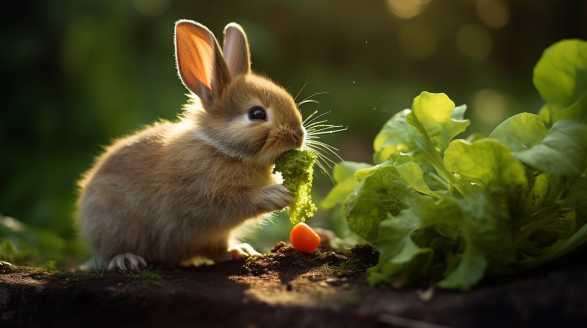Introduction
Hey there, fellow rabbit lovers! Get ready to hop into a world of leafy goodness as we explore the benefits of lettuce in your furry friend’s diet.
Let me tell you, lettuce is not just an ordinary veggie. It’s packed with incredible benefits that can make your rabbit’s tail wag with joy.
Oh, and did I mention it can promote healthy digestion? Get ready to discover the wonder of lettuce for your little furball!
But wait, not all lettuce is created equal. Buckle up as I take you through the different varieties that are not only safe for your bunnies but will have them doing happy binkies in no time.
And let’s not forget the vibrant green and red leaf lettuce varieties that add a splash of color to your rabbit’s plate.
What’s the best way to introduce lettuce to your bunny’s diet, you ask? Don’t worry, I’ve got you covered.
So sit back, relax, and get ready to embark on a lettuce-filled adventure that will have your rabbit hopping with delight!
Now, are you ready to dive headfirst into the world of lettuce benefits for rabbits? Well, let’s get this leafy party started and make your bunny’s taste buds tingle with excitement!
**IceBerg Lettuce Should Not Be Given To Rabbits!
**Do Not Give Any Food To Your Rabbit Without Consulting A Veterinarian
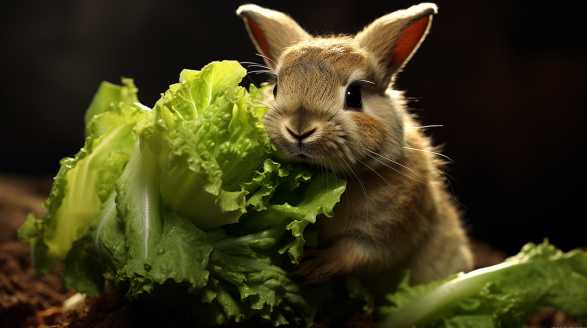
Key Takeaways
- Lettuce is a nutritious addition to a rabbit’s diet, providing hydration, fiber, vitamins, and minerals.
- Romaine, green leaf, red leaf, and butterhead lettuce are safe options for rabbits, each offering unique benefits and flavors.
- Lettuce should be introduced gradually and in moderation to prevent digestive issues.
- It is important to wash lettuce thoroughly before feeding it to rabbits.
- Iceberg lettuce should be avoided as it lacks nutritional value for rabbits.
- A balanced diet for rabbits includes a variety of fresh vegetables, high-quality hay, and a moderate amount of pellets.
- Baby rabbits should start with a diet of hay and gradually introduce safe greens like spinach, beet greens, and Swiss chard.
- Lettuce allergies in rabbits can occur, and it is important to monitor for symptoms and consult a veterinarian if necessary.
- Lettuce aids in maintaining a healthy digestive system for rabbits, promoting proper digestion and preventing gastrointestinal issues.
- Lettuce can be a source of hydration for rabbits, particularly varieties with high water content like romaine lettuce.
- Offering a variety of lettuce types and other water-rich foods helps keep rabbits hydrated and prevents health issues.
- Portion control is important when feeding lettuce to rabbits, with recommended serving sizes of 1-2 cups per day depending on the rabbit’s weight.
- Lettuce should be part of a diverse diet that includes hay, vegetables, and limited fruits for optimal nutrition and health.
- Lettuce varieties like romaine, green leaf, red leaf, butterhead, escarole, and leafy lettuce mixes provide different flavors and nutritional benefits for rabbits.
Benefits of Lettuce in a Rabbit’s Diet: What You Need to Know
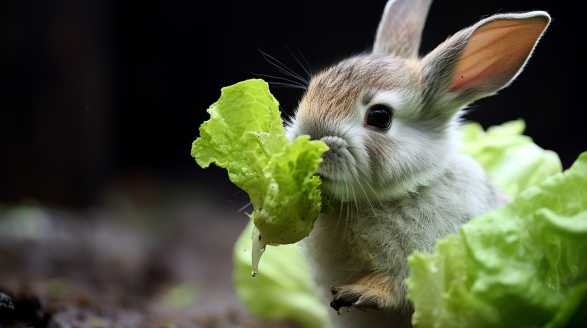
As a rabbit owner, I’ve always been curious about the benefits of incorporating lettuce into my furry friend’s diet. After extensive research and consultations with experts, I have discovered some surprising benefits that I can’t wait to share with you.
Here’s what you need to know about the benefits of lettuce in a rabbit’s diet:
A Nutritional Powerhouse
Lettuce is not just a scrumptious salad ingredient for humans; it’s also packed with essential nutrients that can greatly benefit your rabbit’s overall health. Here are some reasons why lettuce deserves a spot in your bunny’s daily menu:
- Hydration: Lettuce contains a high water content, making it an excellent hydrating food for rabbits. It helps keep your furry pal properly hydrated, reducing the risk of urinary tract issues.
- Vitamins Galore: This leafy green is a fantastic source of various vitamins, including vitamin A, vitamin C, and vitamin K. Vitamin A promotes healthy vision, vitamin C boosts your rabbit’s immune system, and vitamin K supports normal blood clotting.
- Fiber for Digestive Health: Lettuce contains a good amount of dietary fiber that aids in proper digestion. It can prevent gastrointestinal issues, such as diarrhea and bloating, ensuring your rabbit’s tummy stays happy and healthy.
A Variety of Lettuce
Now that we’ve established the benefits of lettuce, it’s important to know that not all lettuce varieties are created equal when it comes to your rabbit’s diet. Here are some lettuce types that you can include in your furry friend’s meal plan:
Romaine Lettuce
Romaine lettuce is a popular choice among rabbit owners due to its nutritional content. It’s crunchy, low in calories, and a great source of vitamin B and folic acid.
Butter Lettuce
If your bunny prefers a softer texture, butter lettuce is an excellent option. It’s gentle on the teeth and provides a good amount of vitamin A and potassium.
Red Leaf Lettuce
For some color in your rabbit’s diet, red leaf lettuce is the way to go. It adds visual appeal and contains the same nutritional benefits as other lettuce varieties.
Safety Measures
While lettuce can be a healthy addition to your rabbit’s diet, there are a few important safety measures to keep in mind:
- Moderation is Key: Although lettuce is beneficial, it should only be given in moderation. Too much lettuce can cause digestive upset due to its high water content and the potential for excess gas.
- Introduce Gradually: When introducing lettuce into your rabbit’s diet, start with small quantities and observe their reaction. Some rabbits have sensitive stomachs and may require an adjustment period.
- Wash and Serve Fresh: Always remember to wash lettuce thoroughly to remove any dirt, pesticides, or harmful chemicals. Serve it fresh to ensure your rabbit receives the maximum nutritional benefits.
- Say No to Iceberg Lettuce: Despite its popularity, it’s advisable to avoid feeding your rabbit iceberg lettuce. It has a high water content but lacks essential nutrients, making it a poor choice for your furry friend.
A Balanced Diet is Key
While lettuce offers tremendous benefits, it should not be the sole component of your rabbit’s diet. A balanced diet for a healthy bunny includes a variety of fresh vegetables, high-quality hay, and a moderate amount of pellets.
Incorporating lettuce into your rabbit’s diet can provide them with essential nutrients, hydration, and aid in proper digestion. However, it’s crucial to offer lettuce in moderation, while keeping in mind your rabbit’s individual needs and preferences.
So, get ready to offer your bunny a delightful leafy treat that will keep them hopping with joy!
Can Baby Rabbits Eat Lettuce? Age-Appropriate Greens for Young Bunnies
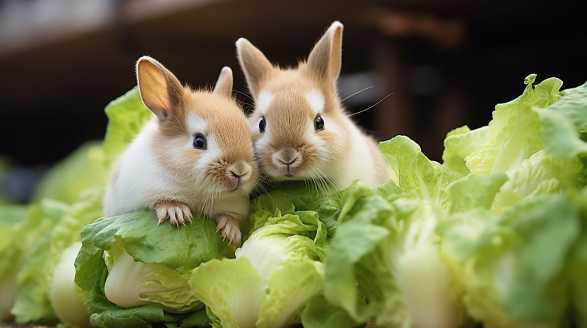
When it comes to keeping baby rabbits happy and healthy, their diet plays a crucial role. As a proud bunny parent, I have often wondered about the safety and appropriateness of certain greens for my little furball.
Join me as I look into this topic and explore the age-appropriate greens for young bunnies.
Understanding the Growing Stages of Baby Rabbits
Before we dive into the specifics of their diet, it’s important to understand the various growth stages of baby rabbits. Typically, the first three weeks are considered the nestling stage, during which their mothers provide them with milk.
This is the stage where their diet becomes a significant factor in their development.
Age-Appropriate Greens for Baby Bunnies
Bunnies, much like humans, have different nutritional requirements as they age. While adult rabbits can consume a variety of greens, including lettuce, baby bunnies have more sensitive tummies.
Safe Greens for Baby Bunnies:
- Hay: Fresh hay, such as timothy or oat hay, should make up the majority of a baby bunny’s diet. It helps maintain a healthy digestive system while allowing them to wear down their ever-growing teeth.
- Pellets: High-quality pellets specifically designed for young rabbits can provide essential vitamins and minerals. However, be sure to follow the recommended serving size to prevent overfeeding.
- Herbs: Adding small amounts of safe herbs, like parsley and cilantro, to your baby bunny’s meals can provide some variety and extra nutrients.
- Leafy greens: As baby bunnies grow, you can gradually introduce baby-friendly leafy greens like spinach, beet greens, and Swiss chard.
Unsafe Greens for Baby Bunnies:
- Iceberg Lettuce: Despite being a popular leafy green, iceberg lettuce contains little nutritional value and high water content. It can lead to diarrhea or digestive issues in baby bunnies.
- Cabbage: While cabbage may seem innocent, it can cause bloating or even gas in baby bunnies due to certain sugars it contains.
- Kale: Despite being nutrient-dense, kale can often be too rough on a baby bunny’s delicate digestive system, leading to discomfort.
Introducing Greens to Baby Bunnies Gradually
Now that we have a better understanding of what greens are safe and suitable for baby bunnies, the next step is the tricky part – introducing them to these new flavors.
To ensure a smooth transition to a greens-based diet, follow these steps:
- Start small: Begin by introducing a single type of green, such as cilantro, to your baby bunny’s diet. This helps them adjust to the new taste and minimizes the risk of digestive upsets.
- Monitor closely: Keep a close eye on your bunny’s stool and behavior during the first few days. Any signs of diarrhea or discomfort may indicate that the green you introduced does not agree with them.
- Gradually add variety: Once your baby bunny has adjusted to the initial green, slowly incorporate other baby-safe greens one at a time. Such variety adds nutritional value and prevents boredom in their diet.
Remember, every bunny is unique, and what works for one may not work for another. Paying attention to your baby bunny’s individual needs and preferences is crucial for their well-being.
Signs of an Unhappy Tummy
Even with the most cautious introduction, some baby bunnies may still experience mild digestive issues. Here are a few signs to watch out for:
- Soft or runny stool: If your bunny’s droppings appear unusually soft or watery, it may be an early indication that the greens you introduced are not suitable for their sensitive tummies.
- Reduced appetite: A sudden loss of interest in food or a decreased appetite could be a sign of digestive discomfort or illness.
- Lethargy: If your baby bunny is less active than usual and seems uninterested in their surroundings, it may be a sign of an unhappy tummy.
If you notice any of these signs, it’s important to consult a veterinarian who specializes in rabbits. They can provide expert advice and recommend appropriate dietary adjustments.
In my journey as a bunny parent, I have learned that ensuring our little fluffballs receive the right diet is crucial for their health and happiness. While baby rabbits can eventually enjoy a wide variety of greens, it’s essential to introduce them gradually, starting with safe options like hay and herbs.
Remember, bunny nutrition is not a one-size-fits-all matter. Observing your bunny’s unique needs, introducing new greens cautiously, and seeking professional advice when needed will help you provide the best diet for your precious furry friend.
Step-by-Step Guide to Introducing Lettuce into Your Rabbit’s Diet
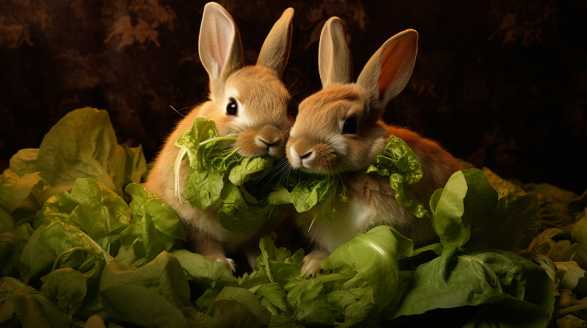
As a proud rabbit owner, I understand the importance of providing a balanced diet for our furry friends. When it comes to introducing new foods, like lettuce, into your rabbit’s diet, taking it one step at a time is crucial to ensure their health and well-being.
Why Introduce Lettuce to Your Rabbit’s Diet?
Lettuce is a fantastic addition to your rabbit’s diet for several reasons. It is low in calories and high in water content, making it a hydrating treat for your furry friend.
The fiber content in lettuce also aids digestion and keeps your rabbit’s gut healthy.
Step 1: Choosing the Right Type of Lettuce
To start, it’s crucial to select the right type of lettuce for your rabbit. While there are various types available, some are more suitable than others.
These options provide more nutrients and are less watery than iceberg lettuce. Remember, variety is key, so feel free to experiment with different types and observe your rabbit’s preferences.
Step 2: Washing and Preparing the Lettuce
Before introducing lettuce to your rabbit’s diet, thorough washing and preparation are essential. Rinse the leaves well under cool water to remove any pesticides or dirt residue.
Wet lettuce can cause discomfort and stomach issues, so ensure the leaves are completely dry.
Step 3: Start with Small Quantities
As with any new food, it’s best to start slowly. Begin by introducing a small amount of lettuce into your rabbit’s diet.
Monitor your rabbit’s reaction for any signs of allergies or digestive distress. If your rabbit displays any adverse effects, discontinue the introduction of lettuce and consult a veterinarian.
Step 4: Observe Your Rabbit’s Tolerance
After introducing lettuce, it’s important to observe how your rabbit tolerates it. Some rabbits may have sensitive stomachs or be more prone to digestive issues.
If your rabbit experiences diarrhea, stomach upset, or refuses to eat lettuce, it may not be the best addition to their diet. Each rabbit is unique, so personalization is key.
Step 5: Gradually Increase the Amount
Once you’ve established that your rabbit tolerates lettuce well, you can gradually increase the quantity. Over a week or two, slowly increase the portion size, paying attention to your rabbit’s reactions and adjusting accordingly.
Remember to maintain a balance by offering hay, pellets, and other leafy greens alongside the lettuce.
Step 6: Mixing Lettuce with Other Foods
To keep your rabbit’s diet interesting, incorporate lettuce into a variety of meals. Mix small pieces of lettuce with their regular hay, pellets, or other leafy greens.
Experiment with different combinations to find the perfect blend that your rabbit loves.
Step 7: Monitor and Adjust as Needed
Rabbits, like humans, have individual preferences and sensitivities. Therefore, it’s crucial to continue monitoring your rabbit’s well-being throughout the process.
Adjust the amount of lettuce or even switch to another leafy green if needed. Remember, maintaining your rabbit’s health is a continuous journey that requires attention and care.
Introducing lettuce into your rabbit’s diet can be a delightful and nutritious experience for both of you. With this step-by-step guide, you’ll be well-equipped to ensure a smooth transition and enjoyable addition to their daily meals.
Mix the lettuce with other foods for a diverse diet and always monitor your rabbit’s tolerance and adjust as needed. Enjoy the process and relish the joy of providing a well-balanced and exciting meal for your beloved bunny companion!
Risks of Feeding Lettuce to Rabbits: Important Precautions
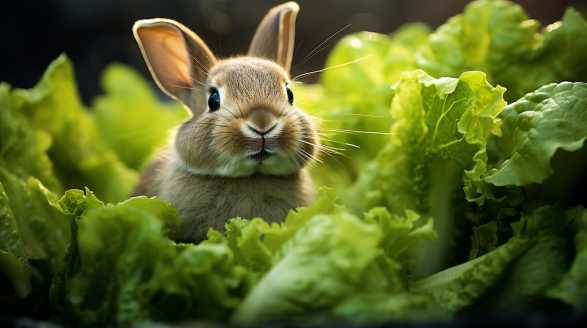
As a rabbit owner, it’s crucial to understand what foods are safe to feed your furry friend and what precautions should be taken. While lettuce is often considered a staple in human salads, it may surprise you to learn that feeding lettuce to rabbits can pose certain risks.
The Lettuce Myth: Breaking the Habit
Myth: Lettuce is a Healthy and Safe Food for Rabbits
Many people have the misconception that lettuce is a healthy and safe food for rabbits. After all, it’s leafy, green, and packed with water content, which sounds like a perfect treat for our floppy-eared friends.
The Truth: Potential Risks of Feeding Lettuce to Rabbits
Despite being popularly consumed by humans, lettuce can be dangerous for rabbits due to certain reasons:
- Lettuce is Low in Nutritional Value: Rabbits require a well-balanced diet to remain healthy, which means they need a variety of nutrients. Lettuce, particularly the iceberg variety, is low in nutritional value and lacks crucial vitamins and minerals that are vital for a rabbit’s well-being.
- High Water Content: While hydration is important, offering a diet consisting primarily of lettuce can lead to diarrhea in rabbits due to its high water content. Diarrhea can quickly dehydrate your bunny and potentially lead to serious health complications.
- Gas and Digestive Problems: The high water content of lettuce can disrupt a rabbit’s digestive system, causing gas and bloating. Rabbits have delicate digestive tracts, making them more susceptible to gastrointestinal issues when fed foods that are difficult to digest.
Essential Precautions to Keep in Mind
Now that we understand the potential risks of feeding lettuce to rabbits, let’s explore some important precautions to ensure the health and well-being of your fluffy friend:
1. Diversify the Diet: Offer a Variety of Vegetables
To provide your rabbit with a well-rounded diet, incorporate a variety of vegetables that are safe for consumption. Opt for leafy greens like kale, spinach, and parsley, which are packed with essential vitamins and minerals.
2. Introduce New Foods Gradually
Rabbits have sensitive digestive systems, so it’s crucial to introduce new foods gradually. When introducing a new vegetable to your rabbit’s diet, start by offering a small portion and observe their reaction.
3. Moderation is Key
While certain vegetables are safe for rabbits, it’s important to remember that moderation is key. Feeding excessive amounts of any food, including lettuce, can lead to adverse health effects.
4. Avoid Lettuce Altogether
Given the potential risks and low nutritional value of lettuce, it is often best to avoid it altogether. There are plenty of other safe options to include in your rabbit’s diet that offer more significant health benefits.
Feeding lettuce to rabbits may seem like a harmless act, but it can pose potential risks to their health and well-being. Remember that a rabbit’s delicate digestive system requires a balanced and nutritious diet to thrive.
By following these precautions, you’ll ensure that your furry friend lives a vibrant and healthy life.
Lettuce Allergies in Rabbits: Identifying and Managing Hypersensitivity
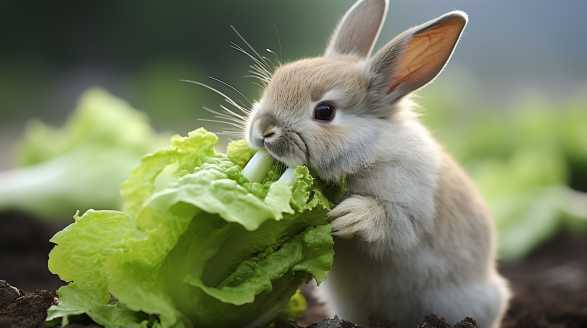
As a rabbit enthusiast, I was taken aback when I discovered that lettuce, one of the staple foods in a rabbit’s diet, could potentially trigger allergies in these adorable furry creatures. I delved into this perplexing topic, conducting extensive research to uncover the facts about lettuce allergies in rabbits.
Understanding Lettuce Allergies: A Burgeoning Concern
The Wonders of Lettuce in a Rabbit’s Diet
Before we dive into the complexities of lettuce allergies, let’s appreciate the vital role this leafy green plays in a rabbit’s diet. Rabbit owners often rely on lettuce as a primary source of nutrition, as it offers a plethora of health benefits, including:
- High water content, aiding in hydration
- Fiber, essential for maintaining healthy digestion
- Vitamins, such as A and K, promoting overall well-being
The Emergence of Lettuce Allergies
In recent years, veterinarians and rabbit owners have noticed a rise in lettuce allergies among rabbits. This perplexing phenomenon has left both professionals and enthusiasts with numerous questions about the causes, symptoms, and management of hypersensitivity in these adorable pets.
Identifying Lettuce Allergies: Watch Out for These Signs!
It is crucial for rabbit owners to be able to identify lettuce allergies in their furry companions promptly. Here are some key signs to watch out for:
- Digestive Distress: If your rabbit experiences diarrhea, bloating, gas, or frequent loose stools after consuming lettuce, it may indicate an allergic reaction.
- Skin Rashes: Redness, itching, or dryness on the skin is another common symptom of lettuce allergies.
- Respiratory Issues: Watch out for sneezing, wheezing, or difficulty breathing after lettuce consumption, as it could signal a hypersensitive reaction.
Diagnosing Lettuce Allergies: Seek Veterinary Expertise
When it comes to diagnosing lettuce allergies in rabbits, professional veterinary assistance is indispensable. Through a comprehensive examination, an astute veterinarian can determine whether your rabbit’s symptoms are indeed caused by lettuce hypersensitivity or another underlying condition.
Managing Lettuce Allergies: Taking Action for Your Rabbit’s Well-being
1. Eliminate Lettuce from the Diet
The most essential step in managing lettuce allergies is to remove lettuce from your rabbit’s diet entirely. Substitute it with other rabbit-safe and allergy-free vegetables, such as:
- Carrots
- Bell peppers
- Celery
- Cucumber
2. Monitor Allergy Triggers
Keep a close eye on your rabbit’s overall diet and monitor their response to alternative vegetables. By observing any recurring symptoms, you will be able to identify other potential allergy triggers besides lettuce, allowing you to make appropriate dietary adjustments.
3. Consult with a Rabbit Nutrition Expert
To ensure your rabbit receives a well-balanced and nourishing diet, it is advisable to seek guidance from a rabbit nutrition expert. They can provide personalized recommendations and alternative food options suited to your rabbit’s specific needs.
Unraveling the complexities surrounding lettuce allergies in rabbits has been an eye-opening journey. By identifying the signs, seeking veterinary expertise, and diligently managing your rabbit’s diet, you can ensure their well-being and provide them with a nutritionally balanced diet that caters to their individual needs.
Understanding the Nutritional Value of Lettuce for Rabbits
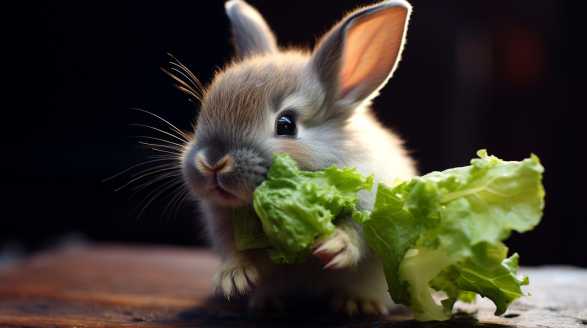
Hey there fellow rabbit lovers! Have you ever wondered about the nutritional value of lettuce for your little fluffy friend?
As a rabbit enthusiast myself, I understand the importance of providing our furry pals with a healthy and balanced diet. we’ll look into the world of lettuce and uncover everything there is to know about its nutritional benefits for rabbits.
Why is Lettuce Vital for Rabbits?
Lettuce is not only a tasty treat for rabbits, but it also boasts numerous nutritional benefits. Including lettuce in your bunny’s diet can promote good health and overall wellbeing.
- Hydration: Rabbits need to maintain proper hydration, and lettuce is an excellent source of water. Its high water content helps keep your furry friend hydrated, especially during warmer months.
- Fiber-rich: A diet that is rich in fiber is essential for optimal gut health in rabbits. Lettuce contains dietary fiber, which aids in digestion and prevents gastrointestinal issues, such as gas and bloating.
- Vitamins and minerals: Lettuce is loaded with essential vitamins and minerals that support your rabbit’s overall health. These include vitamin A, vitamin K, vitamin C, and minerals like potassium and calcium.
Different Types of Lettuce for Rabbits
Lettuce comes in various types, each differing in taste, texture, and nutritional composition. Let’s explore some popular lettuce varieties that are safe and suitable for rabbits:
1. Romaine Lettuce
Romaine lettuce is a go-to choice for many rabbit owners. Its crisp leaves and mild flavor make it enjoyable for bunnies.
2. Butterhead Lettuce
Butterhead lettuce, with its soft and tender leaves, is another excellent option for rabbits. It contains high levels of water and fiber, aiding in hydration and digestive health.
3. Green Leaf Lettuce
Green leaf lettuce is a versatile leafy green that many rabbits love. It offers a good balance of hydration, fiber, and essential nutrients, keeping your bunny happy and healthy.
4. Red Leaf Lettuce
If you want to add a pop of color to your rabbit’s diet, red leaf lettuce is the way to go. With its vibrant red leaves, it not only looks visually appealing but also provides a range of nutrients, including vitamin K, which aids in blood clotting.
How Much Lettuce Should Rabbits Consume?
While lettuce provides numerous benefits for rabbits, it’s important to remember that moderation is key. Incorporating lettuce into a well-balanced diet is the way to go.
- Start slow: Introduce lettuce gradually into your rabbit’s diet, along with their regular food. This helps prevent any digestive upsets or sudden dietary changes.
- Observe portion size: A reasonable portion of lettuce for your rabbit is around one to two cups per day, depending on their size and weight. However, it’s always best to consult with your veterinarian to determine the ideal portion size for your specific bunny.
- Rotate lettuce types: Instead of sticking to just one type of lettuce, try to provide your rabbit with a variety of options. This ensures a diverse range of nutrients in their diet and keeps them excited about mealtime.
Beyond Lettuce: A Balanced Rabbit Diet
While lettuce can be a tasty addition to your rabbit’s diet, it’s essential not to rely solely on it. A balanced rabbit diet comprises various foods that meet their nutritional needs.
- Timothy hay: The foundation of a rabbit’s diet, providing essential fiber and aiding in dental health.
- Fresh vegetables: Carrots, bell peppers, parsley, and cilantro – just to name a few – can be a flavorful addition to your rabbit’s plate.
- High-quality pellets: Ensure you choose pellets specifically made for rabbits, as they contain the necessary nutrients and should be available at all times.
- Limited fruits: While fruits can be a tasty treat, they should be given sparingly due to their higher sugar content.
Well, my fellow rabbit enthusiasts, we’ve explored the wonderful world of lettuce and its nutritional benefits for our fluffy friends. From hydration and fiber to essential vitamins and minerals, lettuce plays a vital role in keeping rabbits healthy and happy.
So, go ahead, spoil your furry companion with some crunchy lettuce leaves – they’ll thank you with a few adorable bunny hops!
The Role of Lettuce in a Rabbit’s Digestive System
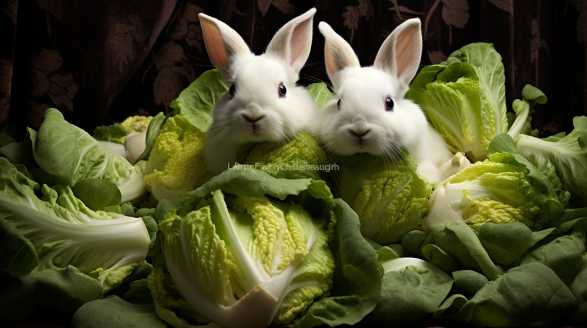
I have always been fascinated by the diverse dietary habits of animals. Recently, my curiosity piqued when I came across the intriguing topic of lettuce’s role in a rabbit’s digestive system.
Allow me to unravel the mysteries of this leafy green vegetable, and look into the fascinating world of a rabbit’s digestive system.
Before we dive into the specifics of lettuce’s role, let’s understand the complex digestive system of our furry friends. You see, rabbits are herbivores, meaning their diet mainly consists of plant material.
Rabbits possess a special sac in their digestive tract called the “cecum,” which plays a vital role in breaking down fibrous plant material. The cecum contains beneficial bacteria and enzymes that aid in the fermentation and digestion of cellulose and other tough plant fibers.
Lettuce: A Rabbit’s Delight
1. Nutritional Benefits
When it comes to a rabbit’s diet, lettuce stands out as a fantastic addition. Not only is it a tasty treat for these furry creatures, but it also provides them with several essential nutrients.
- High Water Content: Lettuce is primarily composed of water, making it an excellent source of hydration for rabbits.
- Vitamins: Lettuce contains various vitamins, including vitamin K, vitamin A, and vitamin C, which help support a rabbit’s overall health and immune system.
- Minerals: This leafy green vegetable is rich in minerals such as calcium and potassium, which are essential for maintaining strong bones and a healthy heart.
2. Act as a Digestive Aid
One of the most crucial roles lettuce plays in a rabbit’s digestive system is its ability to act as a digestive aid. Here’s how lettuce contributes to a healthy and well-functioning rabbit’s digestive system:
- Roughage: The fibrous nature of lettuce helps stimulate a rabbit’s gut motility, ensuring proper movement of food throughout the digestive tract.
- Prevents Hairballs: Rabbits are meticulous groomers, often ingesting their fur in the process. Lettuce’s fiber content aids in the passage of hair through the digestive system, preventing the formation of hairballs.
- Maintains Cecal Balance: The delicate balance of bacteria in a rabbit’s cecum is essential for optimal digestion. Lettuce’s fiber assists in maintaining this balance, promoting healthy bacterial growth and proper fermentation.
3. Variety is Key
While lettuce comes with a myriad of benefits, it is essential to offer rabbits a diverse and balanced diet. Feeding your furry friend only lettuce may result in nutritional imbalances and potential health issues.
- Kale
- Carrots
- Bell peppers
- Bok choy
- Cabbage
The Art of Feeding Lettuce to Your Rabbit
Now that we understand lettuce’s role in a rabbit’s digestive system, let’s explore the best practices for feeding this leafy green vegetable to our fluffy companions.
1. Moderation is Key
While lettuce is undoubtedly a valuable addition to a rabbit’s diet, it is crucial to offer it in moderation. Too much lettuce can lead to loose stools or digestive upset due to its high water content.
2. Variety for the Win
Just like humans, rabbits enjoy a varied diet. Rather than solely relying on one type of lettuce, consider providing a mix of lettuce varieties.
3. Freshness Matters
To ensure your rabbit receives maximum nutritional value, always offer fresh and crisp lettuce. Avoid wilted or spoiled leaves as they can lead to digestive problems.
Who would have thought that a simple leafy green like lettuce could play such a vital role in a rabbit’s digestive system? From being a nutritional powerhouse to aiding digestion and preventing hairballs, lettuce is truly a rabbit’s delight.
So, next time you see a vibrant head of lettuce, remember its importance in the digestive prowess of these incredible creatures.
How Much Lettuce Should You Feed Your Rabbit? Portion Control Tips
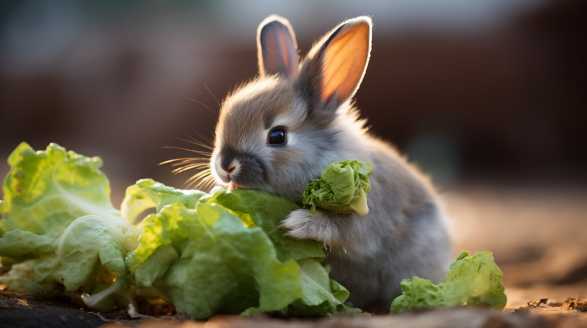
As a rabbit owner, one of the many questions you may have is about your furry friend’s diet. Lettuce, being a staple vegetable, is often considered a go-to option for feeding rabbits.
Is it safe to offer a large portion? Let’s dive into this topic and explore some portion control tips.
Why is Portion Control Important?
Before we look into specific portion sizes for rabbits, it’s essential to understand why portion control matters. Just like humans, rabbits need a balanced diet to maintain proper health and well-being.
Maintaining the correct portion size of lettuce ensures that your rabbit receives adequate nutrition while preventing any unwanted consequences.
The Ideal Portion Size
When it comes to lettuce, it’s crucial to keep in mind that it should only be a small part of your rabbit’s overall diet. Too much lettuce can cause health issues such as diarrhea or other digestive problems.
- Limited to 1-2 Cups per Day: A suitable portion of lettuce for your rabbit is generally around 1-2 cups per day. This amount should consist of a variety of lettuces to provide different nutrients for your pet.
- Gradual Introduction: If you are introducing lettuce to your rabbit’s diet for the first time, it’s essential to start slowly. Begin with a small portion (1/8 cup) and gradually increase it over a few days to prevent any potential digestive issues.
- Monitor Your Rabbit’s Response: As you introduce lettuce or adjust the portion size, keep a close eye on your rabbit’s behavior. Any unusual changes in appetite or bowel movements may indicate a need to adjust the portion accordingly.
- Consult with a Vet: Each rabbit is unique, and the ideal portion size may vary based on your rabbit’s age, weight, and overall health. It’s always best to consult with a veterinarian who can provide personalized recommendations for your furry friend.
Ideal Types of Lettuce for Rabbits
Not all types of lettuce are safe for rabbits to consume. Some types may contain higher levels of harmful compounds or lack essential nutrients.
1. Romaine Lettuce
Romaine lettuce is a popular choice among rabbit owners due to its high fiber content and low sugar content. It’s always best to choose fresh, organic romaine lettuce and rinse it thoroughly before feeding it to your rabbit.
2. Green Leaf Lettuce
Green leaf lettuce, characterized by its vibrant green leaves, is another suitable option for rabbits. As with all lettuces, it’s important to offer this variety in moderation and ensure it is clean and free from any pesticides.
3. Butter Lettuce
Butter lettuce, with its soft and tender leaves, can be a delightful treat for your rabbit. However, remember that it should only be given in small quantities due to its higher water content compared to other lettuce varieties.
4. Red Leaf Lettuce
Red leaf lettuce is known for its rich color and slightly bolder taste. While this lettuce can add some variety to your rabbit’s diet, be cautious not to overfeed it, as excess consumption may lead to digestive issues.
Follow These Tips for Portion Control
Here are some additional tips to help you maintain portion control while feeding lettuce to your rabbit:
1. Rotate Types of Lettuce
To provide a well-rounded diet, rotate the types of lettuce you offer your rabbit. This ensures that they receive a variety of nutrients and flavors without consuming excessive amounts of a single type.
2. Incorporate Other Vegetables
Lettuce should never be the sole vegetable in your rabbit’s diet. Introduce other vegetables, such as dark leafy greens, carrots, bell peppers, or herbs like parsley or cilantro.
3. Avoid Iceberg Lettuce
While iceberg lettuce is commonly found in households, it should be avoided when feeding rabbits. This variety lacks the necessary nutrients and can cause digestive issues if consumed excessively.
4. Offer Hay as a Staple
Hay is an important part of a rabbit’s diet, providing essential fiber and promoting healthy digestion. Be sure to offer unlimited access to fresh hay to ensure your rabbit’s well-being.
Lettuce can be a complementary addition to your rabbit’s diet, but portion control is key. Stick to the recommended 1-2 cups per day and diversify the types of lettuce offered to ensure a balanced intake of nutrients.
By maintaining proper portion control, your rabbit will hop into a healthy and happy life!
Lettuce Varieties Safe for Rabbits: A Comprehensive Guide
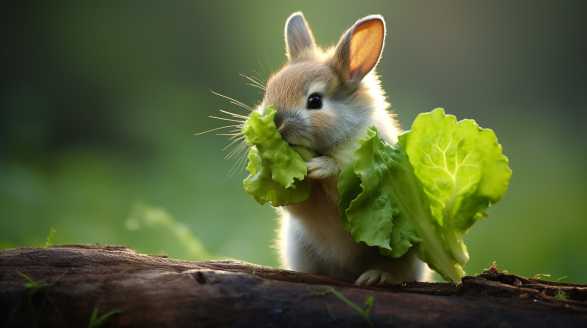
Hey there fellow bunny lovers! Are you searching for the best lettuce varieties to keep your adorable rabbits hopping with joy?
I’ll walk you through the various lettuce types that are not only safe for our furry friends, but will also make their taste buds dance. So, let’s get acquainted with the most delightful rabbit-approved lettuce options out there!
But First, a Note of Caution
Before we start exploring the world of lettuce varieties, let me remind you to introduce any new foods to your bunnies gradually. Rabbits have sensitive digestive systems, so it’s vital to limit the initial serving and monitor their response for any signs of stomach upset.
Romaine Lettuce: Crisp, Crunchy, and Delightful
If you’re looking for a lettuce type that is both nutritious and adored by rabbits, romaine lettuce should be your top choice. Here’s why:
- It provides a tasty source of vitamins A, C, and K
- Romaine lettuce has a high water content, helping to keep your bunnies hydrated
- Its natural crispness and crunchiness offer a wonderful texture for munching
Butterhead Lettuce: Soft and Flavorful
Looking to add a touch of tenderness to your bunny’s diet? Butterhead lettuce might just be the perfect option.
- The soft leaves are easy on sensitive bunny tummies
- Butterhead lettuce is packed with vitamins and minerals, including folate and potassium
- Its rich flavor adds an extra element of enjoyment to your furry friend’s mealtime
Green Leaf Lettuce: A Classic Favorite
Ah, the classic green leaf lettuce! This timeless choice offers a delightful combination of taste and nutrition.
- Green leaf lettuce is a fantastic source of vitamins A and K, as well as folate
- Its leafy, loose structure makes it fun and easy for bunnies to nibble on
- Your rabbits will never get bored with its refreshing and slightly bitter taste
Red Leaf Lettuce: A Splash of Color and Flavor
Who says rabbits don’t appreciate a little vibrancy in their diet? Red leaf lettuce not only adds a pop of color to their plate but also brings an exciting twist to mealtime.
- Packed with vitamins A and K, red leaf lettuce promotes overall vitality
- Its slightly stronger flavor compared to green leaf lettuce provides a thrilling change of pace
- The beautiful red hue adds visual appeal to your bunny’s dining experience
Escarole Lettuce: A Nutritional Powerhouse
Now it’s time to introduce a lettuce variety that takes health benefits to the next level: escarole lettuce. Your bunnies will adore this green hero for the following reasons:
- Escarole lettuce is rich in vitamins A, C, and K, making it a true nutritional powerhouse
- Its slightly bitter taste adds a tantalizing twist to their meals
- This variety is gentle on sensitive rabbit stomachs, making it an ideal choice for our furry friends with delicate digestion
Leafy Lettuce Mix: A Bouquet of Flavors
Why settle for one lettuce variety when you can treat your bunnies to a feast of flavors? Leafy lettuce mixes offer a tantalizing blend of different lettuce types.
- The mix provides a diverse range of vitamins and minerals, ensuring your bunnies get a well-rounded meal
- The combination of textures and flavors keeps mealtime exciting and prevents boredom
- Leafy lettuce mixes often include both green and red varieties, adding a visual feast to your bunny’s bowl
Well, folks, we’ve journeyed through the glorious realm of lettuce varieties safe for rabbits, and what a delightful adventure it has been! Remember to prioritize your bunny’s health by introducing new foods gradually, monitoring their reactions, and keeping portion sizes appropriate.
Happy feeding, my fellow bunny enthusiasts!
Conclusion
Alright, fellow bunny lovers, we’ve hopped through the wonderful world of lettuce and its incredible benefits for our furry friends! From its hydrating properties and essential vitamins to its role in maintaining a healthy digestive system, lettuce has proven time and time again to be a superstar in a rabbit’s diet.
Watching my bunnies munching on their favorite lettuce leaves brings me so much joy and satisfaction.
As I wrap up this lettuce-filled adventure, I can’t help but emphasize the importance of moderation and variety in a rabbit’s diet. Lettuce is a fantastic addition, but it should never be the sole component.
So, fellow bunny enthusiasts, let’s continue to provide our fluffy companions with a diverse and exciting diet. Let’s watch their little noses twitch with delight as they explore the world of romaine, butterhead, green and red leaf, escarole, and leafy lettuce mixes.
It’s been a journey uncovering the wonders of lettuce for rabbits. The crunchy bites, the refreshing hydration, the nutritional benefits, and the joy it brings to our bunnies are all worth celebrating.
Thank you for joining me on this adventure, and here’s to many more lettuce-filled moments of fun, love, and hopping happiness with our beloved bunnies!
Frequently Asked Questions
Q: Is lettuce safe for rabbits to eat?A: Yes, lettuce is safe for rabbits to eat, but certain types should be avoided.
Q: What types of lettuce can rabbits eat?A: Rabbits can eat leafy green lettuces such as romaine, green leaf, and red leaf lettuce.
Q: Can rabbits eat iceberg lettuce?A: It is not recommended to feed rabbits iceberg lettuce, as it has little nutritional value and may cause digestive issues.
Q: How much lettuce should I feed my rabbit?A: Lettuce should only be a small portion of your rabbit’s diet. Offer a few small, washed lettuce leaves as a treat or part of a balanced diet.
Q: Can rabbits eat lettuce every day?A: It is best to offer lettuce to rabbits as a treat or occasional addition to their diet, rather than a daily food source. Variety is important for their overall well-being.
Q: Can lettuce be harmful to rabbits?A: While lettuce is generally safe for rabbits, some varieties like iceberg lettuce can cause digestive problems if consumed in large quantities. Always introduce new foods slowly and monitor your rabbit’s reaction.
Q: What other vegetables can rabbits eat besides lettuce?A: Rabbits can safely consume a variety of vegetables such as carrots, bell peppers, cucumbers, and dark leafy greens like kale and spinach. However, it is essential to introduce new vegetables gradually and in small amounts to avoid any digestive issues.
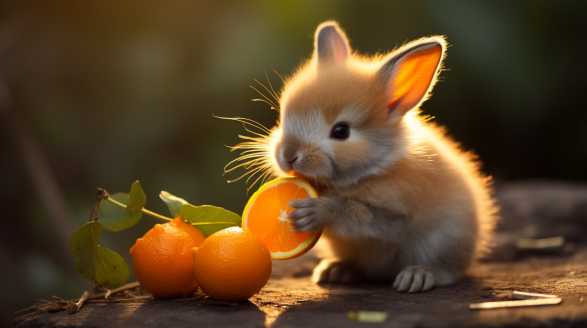
Can Rabbits Eat Oranges
Introduction Can rabbits eat oranges? Let’s find out. Picture this: you and your adorable bunny, basking in the sun, enjoying a delightful snack together. You’re munching on a juicy orange slice, savoring the tangy sweetness as your rabbit curiously sniffs around, its twitchy nose catching whiffs of the citrusy aroma. But wait, you pause to […]
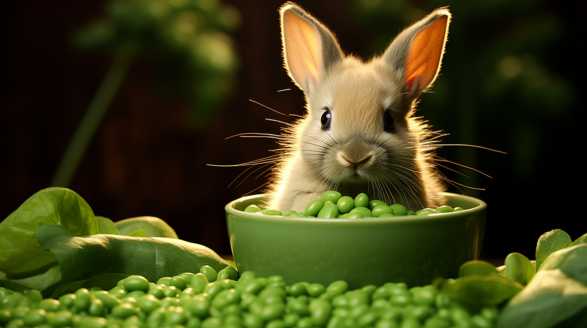
Can Rabbits Eat Peas
Introduction Hey there, fellow rabbit enthusiast! Have you ever considered adding peas to your furry friend’s diet? we’ll dive into the world of peas and explore why they should be a delightful addition to your bunny’s menu. Pea hay, derived from the foliage of the pea plant, is a fantastic option for rabbits. It contains […]
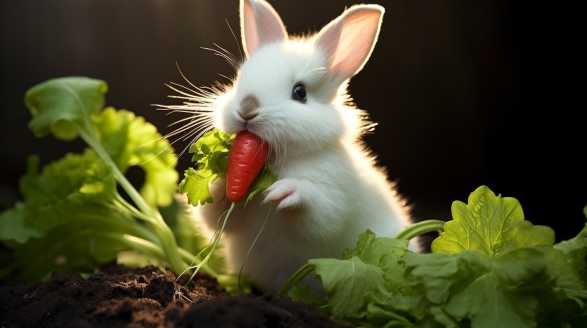
Can Rabbits Eat Radishes
Introduction Can rabbits eat radishes? Let’s find out. Picture this: a curious bunny hops into the room and sees you holding a radiant red radish. Suddenly, their eyes widen, ears perk up, and they can’t help but hop over to investigate. Well, that’s exactly what happened to me, and let me tell you, it was […]
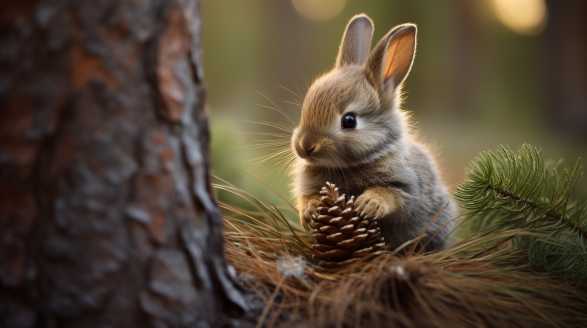
Do Rabbits Eat Pine Cones
Introduction Can rabbits eat pine cones? Let’s find out. Get ready to dive into a world of excitement and discovery as we explore the fascinating topic of feeding pine cones to our furry friends. I couldn’t help but put on my investigative hat and go down the rabbit hole (pun intended) to bring you all […]
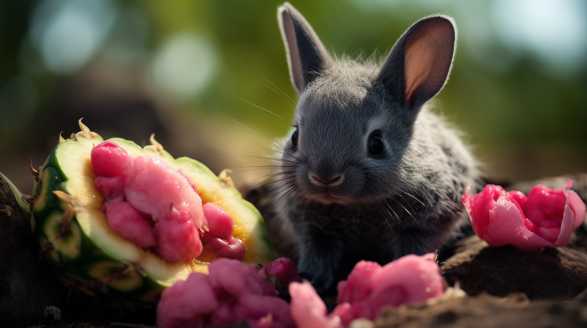
Can Rabbits Eat Dragonfruit
Introduction Can Rabbits eat dragonfruit? Let’s find out. Dragons and rabbits coming together through the magical world of fruit. Who knew? Now, let’s pause for a moment and imagine the possibilities. Dragonfruit, with its vibrant hues and exotic taste, has captivated the hearts of fruit enthusiasts around the globe. Well, my friends, today I am […]

Can Rabbits Eat Kale
Introduction Can rabbits eat kale? Let’s find out. Now, picture this: fluffy bunnies bouncing around, their fur glistening in the sunlight, and their skin looking oh-so-smooth and radiant. Have you ever wondered what their secret is? Believe it or not, kale is not only a superfood for us humans, but it also packs a punch […]

